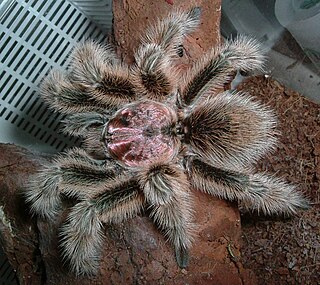
Anyphaenidae is a family of araneomorph spiders, sometimes called anyphaenid sac spiders. They are distinguished from the sac spiders of the family Clubionidae and other spiders by having the abdominal spiracle placed one third to one half of the way anterior to the spinnerets toward the epigastric furrow on the underside of the abdomen. In most spiders the spiracle is just anterior to the spinnerets. Like clubionids, anyphaenids have eight eyes arranged in two rows, conical anterior spinnerets and are wandering predators that build silken retreats, or sacs, usually on plant terminals, between leaves, under bark or under rocks. There are more than 600 species in over 50 genera worldwide.

Grammostola is a genus of South American tarantulas that was first described in text by Eugène Louis Simon in 1892. These medium- to large-sized spiders are native to tropical South America, and are usually brown in color, with pinkish or orangish-red hairs. The very docile Chilean rose tarantula is popular as a beginner's spider among tarantula enthusiasts.

Missulena is a genus of mygalomorph spiders in the family Actinopodidae. It was first described by Charles Walckenaer in 1805, and is a senior synonym of Eriodon. M. tussulena is found in Chile, but the rest are indigenous to Australia. They are sometimes referred to as "mouse spiders" from the now-disproven belief that they dig deep burrows similar to those of mice. Scotophaeus blackwalli is also called a "mouse spider", but it is smaller and not closely related.

Tullgrenella is a genus of South American jumping spiders that was first described by Cândido Firmino de Mello-Leitão in 1941. It is named after Swedish arachnologist Albert Tullgren, and is a senior synonym of Akeloides.

Actinopus is a genus of mygalomorph spiders in the family Actinopodidae. It was first described by Josef Anton Maximilian Perty in 1833 from the type species Actinopus tarsalis found in Brazil. The name is derived from Greek actin- "ray, beam" and pous "foot". It is a senior synonym of Aussereria, Closterochilus, Pachyloscelis, and Theragretes.

Nemesiidae, also known as funnel-web trapdoor spiders, is a family of mygalomorph spiders first described by Eugène Simon in 1889, and raised to family status in 1985. Before becoming its own family, it was considered part of "Dipluridae".
Sanogasta is a genus of South American anyphaenid sac spiders first described by Cândido Firmino de Mello-Leitão in 1941.
Lycinus frayjorge is a mygalomorph spider of Chile, named after its type locality: Parque Nacional Fray Jorge, Limarí, Region IV (Coquimbo). The female spermathecae are most similar to those of L. gajardoi, which differs by the less numerous maxillary cuspules, the lighter scopula IV, and the presence of pseudopreening combs.
Chaco patagonica is a species of mygalomorph spiders of Argentina, named after its type locality in Patagonia, specifically Chubut Province, Argentina. The species can be distinguished from C. tecka by not having a patterned cephalothorax and legs, by possessing less maxillary cuspules and by the absence of pseudopreening combs. It also differs from C. sanjuanina by having few labial cuspules.

Acanthogonatus is a genus of South American mygalomorph spiders in the family Pycnothelidae. It was first described by Ferdinand Anton Franz Karsch in 1880. Originally placed with the brushed trapdoor spiders, it was transferred to the funnel-web trapdoor spiders in 1985, then to the Pycnothelidae in 2020.
Lycinus is a genus of spider in the family Pycnothelidae, found in parts of South America.
Stenoterommata is a genus of South American araneomorph spiders in the family Pycnothelidae. It was first described by E. L. Holmberg in 1881. Originally placed with the Ctenizidae, it was transferred to the funnel-web trapdoor spiders in 1985, then to the Pycnothelidae in 2020. It is a senior synonym of Ctenochelus.
Pycnothele is a genus of South American mygalomorph spiders in the family Pycnothelidae. First described by Ralph Vary Chamberlin in 1917, it was moved to the funnel-web trapdoor spiders in 1985, but moved back to Pycnothelidae in 2020. It is a senior synonym of Agersborgia and Androthelopsis.
Diapontia is a genus of spiders in the family Lycosidae. It was first described in 1877 by Keyserling.
Pycnothele labordai is a species of South American mygalomorph spiders in the family Pycnothelidae. It is the only species in the monotypic genus Pycnothele. It was first described by F. Pérez-Miles, F. G. Costa & L. Montes de Oca in 2014 under the genus Bayana, and is found in Uruguay and Brazil. Originally placed with the funnel-web trapdoor spiders, it was transferred to the Pycnothelidae in 2020.

Pycnothelidae is a family of mygalomorph spiders first described in 1917. It was downgraded to a subfamily of the funnel-web trapdoor spiders in 1985, but returned to family status in 2020.
Euagridae is a family of mygalomorph spiders. The group was first described as a tribe in 1979 by Robert Raven, who in 1985 elevated it to a subfamily. In 2020, Opatova et al. elevated it further to a family.







